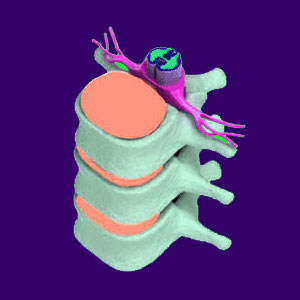
Nerve roots are divisions in the spinal cord which branch off between the vertebral bones, forming the network of nerves which serve the various anatomical regions of the body. It is these neurological structures that are often implicated in being impinged upon by some spinal abnormality, such as a bulging disc or an osteoarthritic process. Spinal roots are the origin of most of the body’s neurological tissues. The sheer diversity of tissue types that form from these roots is truly extraordinary and the functionality facilitated has made humans the amazing species that they have become over eons of evolution.
This dissertation explores the spinal neurological roots and how they often figure into various back pain diagnoses.
Nerve Root Facts
The roots of the spinal nerves form the very origins of a vast and extremely complex system of neurological tissues which run throughout the anatomy. Almost all the nerves in the body have their start as a neurological root. The spine provides terrific protection for these nerves, by enclosing them in vertebral bone and surrounding them with protective membranes and the added cushion of cerebral spinal fluid. While the nerves are usually insulated from harm or interference, a variety of conditions can cause them actual damage or affect them in a manner which prevents proper neurological functionality.
There are 8 cervical roots, 12 thoracic roots, 5 lumbar roots, 5 sacral roots and one coccygeal root. Each neurological root consists of 2 halves, the dorsal root and the ventral root. These halves join together to form a complete spinal nerve. The ventral root, or anterior root, is responsible for motor functions. The dorsal root, or posterior root, is responsible for sensory functions.
In the cervical and thoracic spinal regions, the neurological roots separate from the spinal cord, then exit through openings in between each vertebrae called foramen. In the lumbar spine, the spinal cord has already broken up into the cauda equina, but the individual neurological roots still exit between each vertebral bone.
In the sacrum and the coccyx, nerves continue to exit to each side, despite the natural fusion of vertebral bones in these 2 last spinal regions. There is only one coccygeal nerve which exits out of the bottom of the spinal column, not bilaterally as in the case of all the others.
Spinal Nerve Disorders
Many doctors believe that compression of, or impingement upon, the spinal neurological roots is the primary cause of most back pain conditions. This compression is most commonly caused by herniated discs, foraminal stenosis or some spinal arthritic process. Other doctors recognize that true nerve compression is rare and that chronic pinched nerve pain is an uncommon occurrence.
Severe nerve compression can occur despite its rarity and might be a serious condition requiring emergency medical attention. Cauda equina syndrome is one possible result of true lumbar neurological root compression which necessitates immediate medical treatment to prevent permanent damage.
Remember the proven scientific fact that continued compression of a spinal nerve root will cause the nerve to stop signalling. The outcome of such an occurrence is not chronic pain, as is widely reported in medical mythology, but instead, objective versions of numbness, followed by weakness in the innervated region of the body.




